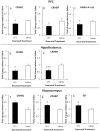Functional programming of the autonomic nervous system by early life immune exposure: implications for anxiety
- PMID: 23483921
- PMCID: PMC3590226
- DOI: 10.1371/journal.pone.0057700
Functional programming of the autonomic nervous system by early life immune exposure: implications for anxiety
Abstract
Neonatal exposure of rodents to an immune challenge alters a variety of behavioural and physiological parameters in adulthood. In particular, neonatal lipopolysaccharide (LPS; 0.05 mg/kg, i.p.) exposure produces robust increases in anxiety-like behaviour, accompanied by persistent changes in hypothalamic-pituitary-adrenal (HPA) axis functioning. Altered autonomic nervous system (ANS) activity is an important physiological contributor to the generation of anxiety. Here we examined the long term effects of neonatal LPS exposure on ANS function and the associated changes in neuroendocrine and behavioural indices. ANS function in Wistar rats, neonatally treated with LPS, was assessed via analysis of tyrosine hydroxylase (TH) in the adrenal glands on postnatal days (PNDs) 50 and 85, and via plethysmographic assessment of adult respiratory rate in response to mild stress (acoustic and light stimuli). Expression of genes implicated in regulation of autonomic and endocrine activity in the relevant brain areas was also examined. Neonatal LPS exposure produced an increase in TH phosphorylation and activity at both PNDs 50 and 85. In adulthood, LPS-treated rats responded with increased respiratory rates to the lower intensities of stimuli, indicative of increased autonomic arousal. These changes were associated with increases in anxiety-like behaviours and HPA axis activity, alongside altered expression of the GABA-A receptor α2 subunit, CRH receptor type 1, CRH binding protein, and glucocorticoid receptor mRNA levels in the prefrontal cortex, hippocampus and hypothalamus. The current findings suggest that in addition to the commonly reported alterations in HPA axis functioning, neonatal LPS challenge is associated with a persistent change in ANS activity, associated with, and potentially contributing to, the anxiety-like phenotype. The findings of this study reflect the importance of changes in the perinatal microbial environment on the ontogeny of physiological processes.
Conflict of interest statement
Figures






Similar articles
-
Neonatal lipopolysaccharide and adult stress exposure predisposes rats to anxiety-like behaviour and blunted corticosterone responses: implications for the double-hit hypothesis.Psychoneuroendocrinology. 2009 Nov;34(10):1515-25. doi: 10.1016/j.psyneuen.2009.05.010. Epub 2009 Jun 12. Psychoneuroendocrinology. 2009. PMID: 19524372
-
Increased microglial activation in the rat brain following neonatal exposure to a bacterial mimetic.Behav Brain Res. 2012 Jan 1;226(1):351-6. doi: 10.1016/j.bbr.2011.08.038. Epub 2011 Sep 1. Behav Brain Res. 2012. PMID: 21907243
-
Altered nociceptive, endocrine, and dorsal horn neuron responses in rats following a neonatal immune challenge.Psychoneuroendocrinology. 2014 Mar;41:1-12. doi: 10.1016/j.psyneuen.2013.11.016. Epub 2013 Dec 4. Psychoneuroendocrinology. 2014. PMID: 24495603
-
Activation of the hypothalamic-pituitary-adrenal axis and autonomic nervous system during inflammation and altered programming of the neuroendocrine-immune axis during fetal and neonatal development: lessons learned from the model inflammagen, lipopolysaccharide.Brain Behav Immun. 2006 Mar;20(2):144-58. doi: 10.1016/j.bbi.2005.05.003. Epub 2005 Jul 14. Brain Behav Immun. 2006. PMID: 16023324 Review.
-
Early environmental regulation of forebrain glucocorticoid receptor gene expression: implications for adrenocortical responses to stress.Dev Neurosci. 1996;18(1-2):49-72. doi: 10.1159/000111395. Dev Neurosci. 1996. PMID: 8840086 Review.
Cited by
-
Prenatal programming of mental illness: current understanding of relationship and mechanisms.Curr Psychiatry Rep. 2015 Feb;17(2):5. doi: 10.1007/s11920-014-0546-9. Curr Psychiatry Rep. 2015. PMID: 25617041 Free PMC article. Review.
-
Hypothalamic-Pituitary-Adrenal Axis Programming after Recurrent Hypoglycemia during Development.J Clin Med. 2015 Aug 28;4(9):1729-40. doi: 10.3390/jcm4091729. J Clin Med. 2015. PMID: 26343738 Free PMC article. Review.
-
Inflammation early in life is a vulnerability factor for emotional behavior at adolescence and for lipopolysaccharide-induced spatial memory and neurogenesis alteration at adulthood.J Neuroinflammation. 2014 Sep 17;11:155. doi: 10.1186/s12974-014-0155-x. J Neuroinflammation. 2014. PMID: 25224537 Free PMC article.
-
Plasma Proteomic Profiling of a Group of Anxious Dogs by LC-MS/MS: A Case-Control Study.Proteomics Clin Appl. 2025 Jul;19(4):e70014. doi: 10.1002/prca.70014. Epub 2025 Jul 4. Proteomics Clin Appl. 2025. PMID: 40614171 Free PMC article.
-
Biochemical, histopathological and morphological profiling of a rat model of early immune stimulation: relation to psychopathology.PLoS One. 2015 Jan 20;10(1):e0115439. doi: 10.1371/journal.pone.0115439. eCollection 2015. PLoS One. 2015. PMID: 25602957 Free PMC article.
References
-
- Dombrowski SC, Martin RP, Huttunen MO (2003) Association between maternal fever and psychological/behavior outcomes: a hypothesis. Birth Defects Res A Clin Mol Teratol 67: 905–910. - PubMed
-
- Craske MG, Poulton R, Tsao JC, Plotkin D (2001) Paths to panic disorder/agoraphobia: an exploratory analysis from age 3 to 21 in an unselected birth cohort. J Am Acad Child Adolesc Psychiatry 40: 556–563. - PubMed
-
- Walker AK, Nakamura T, Byrne RJ, Naicker S, Tynan RJ, et al. (2009) Neonatal lipopolysaccharide and adult stress exposure predisposes rats to anxiety-like behaviour and blunted corticosterone responses: implications for the double-hit hypothesis. Psychoneuroendocrinology 34: 1515–1525. - PubMed
-
- Walker AK, Hiles SA, Sominsky L, McLaughlin EA, Hodgson DM (2011) Neonatal lipopolysaccharide exposure impairs sexual development and reproductive success in the Wistar rat. Brain Behav Immun 25: 674–684. - PubMed
Publication types
MeSH terms
Substances
LinkOut - more resources
Full Text Sources
Other Literature Sources
Medical

